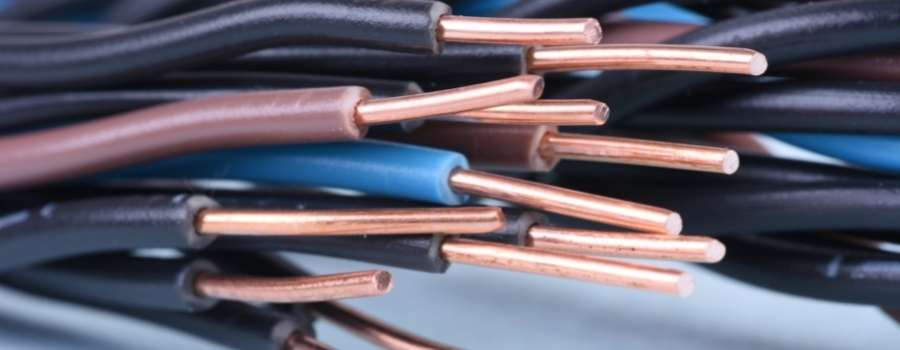Romex wire…which is technically known as “non-metallic sheathed cable”…is a popular type of wiring in home construction and renovation. But what about for solar panel installation?
Generally, romex wire isn’t rated for damp or wet conditions and should never be used on solar panel installations. The risk of fire and other hazards outweighs any monetary savings that might come from using this type of wiring.

It’s an ideal choice for indoor use where the temperature and humidity are fairly low and consistent, but you need to use a lot of caution if you plan to do any construction that might be exposed to the weather…like solar panel installation.
What Is Romex Wire?
Romex wire is a type of electrical wiring used in residential and commercial construction. It’s typically available as 14-gauge, 12-gauge, or even thinner gauges for specialized applications. Romex wire is made from either copper or aluminum with a PVC coating that makes it resistant to corrosion.
The insulation on the wire is rated for damp and wet conditions, but the wire itself should never be exposed to water. It’s not designed for outdoor use or in any other environment where it might come into contact with moisture.
What Is Romex Wire Used For?
Romex wire is usually used for indoor wiring in residential or commercial construction. It’s also a popular choice for temporary installation projects, like when you need to move an outlet from one place to another temporarily.
Since it isn’t rated for outdoor use, you should never use Romex wire for solar panel installation.
Why Shouldn’t I Use Romex Wire In Solar Installation?

Romex wire is not designed for outdoor use. The PVC insulation will eventually deteriorate and the steel wire inside will rust or corrode, which can cause electrical shorts and arc in wet conditions.
Potential hazards from using Romex wiring include:
- Fire
- Short-Circuiting
- Increased Heat Buildup
- Overloads
- Electrical Shocks if Exposed to Water
Electrical fires and equipment damage due to the insulation on Romex wire deteriorating in damp or wet environments.
Can Romex Run Inside Of Conduit?
Typically, it’s not recommended because Romex wire is designed to be only exposed on the surface and not buried inside a conduit. In addition, it should never be used in wet or damp conditions like in an outdoor solar panel installation.
Instead of using Romex wire for this purpose, you can use something that is rated for outdoor use and can withstand the conditions of an outdoor solar panel installation.
What Kind Of Wire Should I Use On Solar Panels?
In general, aluminum or copper wire is going to be the most common and ideal wiring used with solar panels. Aluminum wire is typically used for indoor and outdoor solar panel installations, but copper wiring is better suited to be buried in conduit outdoors since it’s a higher gauge than.
The common type of cable that you’ll see on residential solar panels is MC-type cables…MC cables are rated for wet or damp conditions… with rubber insulation and conductors made from either aluminum or copper.
Though not required for most home installations, it’s important to use wiring that has been tested by an independent lab so that it meets the UL standards.
Since copper is a better conductor, it’s what you’ll see on the higher-end residential solar panels. Most people opt to use wiring…called Photovoltaic (PV) wire…that is specifically designed for solar installations.
What Is Photovoltaic Wire?
Photovoltaic (PV) wire is a type of wiring that can be used in solar panel installations. It’s typically made from copper with an aluminum or steel core and water-resistant insulation coating rated for wet or damp conditions.
The outer jacket on PV cable often has ribbing which helps to protect against abrasion, but it’s not recommended to use this type of wire for high-voltage or long distances.
The PVC insulation will eventually deteriorate and the steel wire inside will rust or corrode, which can cause electrical shorts and arc in wet conditions.
How Much Does Photovoltaic Wire Cost?
Typically, a 100-foot of photovoltaic wire will cost about $2000 however, different manufacturers may charge more or less depending on materials used and market trends. The only requirement is that the wire follows UL-4703 standards.
| Conductor Size | 18 AWG — 2000 kcmil |
| Material | Copper, Aluminum, Copper Wrapped Aluminum |
| Insulation | XLPE (Polyethylene) EPR (Ethylene Propylene Rubber) |
| Voltage | 600 V |
| Durability | Sunlight Resistant |
| Temperature Rating | 194 F – Wet, 221-302 F – Dry |
| Construction | Non-Armored, Single Conductor |
Can Photovoltaic Wire Be Used In Conduit?
Photovoltaic (PV) wire can be used in conduit for solar panels. It’s typically made from aluminum or copper with an aluminum or steel core and water-resistant insulation coating rated for wet or damp conditions.
Because it has a higher gauge, the PV cable is better suited to be buried in conduit outdoors since it’s designed to withstand outdoor conditions.
The PVC insulation will eventually deteriorate and the steel wire inside will rust or corrode, which can cause electrical shorts and arc in wet conditions.
Final Thoughts
Always have a plan and get opinions from solar professionals about what the best options are for your solar panel array.
Just know that Romex wire is not a recommended solution for outdoor use, though you might be able to use it on the indoor portion of your solar setup.
It’s generally a good idea to use photovoltaic wire since it is specifically designed for outdoor use with solar panels, but at the very least use wiring that is rated for outdoor use.

